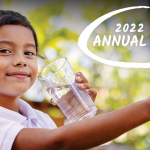Sensors and Sensibility
 With the familiar ‘Dinggg!’ of his cell phone, Brayan, EOS circuit rider and sensor technician in Honduras, receives an automated text message from the depths of the Florida de Marcala community water tank. The message is polite and to the point: “The chlorine level is low. Please check the chlorinator to confirm there are tablets.”
With the familiar ‘Dinggg!’ of his cell phone, Brayan, EOS circuit rider and sensor technician in Honduras, receives an automated text message from the depths of the Florida de Marcala community water tank. The message is polite and to the point: “The chlorine level is low. Please check the chlorinator to confirm there are tablets.”
Two weeks earlier, Brayan had received a similar dinggg. But it was only a test. Pushed through to his phone by Megan, EOS Technical Program Manager, seated across the room from him in our Marcala office, the test ding had meant all systems-a-go to usher in the next phase of EOS’ water quality sensor program — real-time alerts from real-time sensors!

With support from Xylem Inc., a leader in innovative smart technology water solutions, and in collaboration with the University of Iowa’s engineering department, six pilot program sensors installed in community water tanks in rural Honduras have been collecting tank level and water quality data and sending it to a digital platform for monitoring and recording since their deployment in 2022. Paired with chlorine monitoring data collected manually and routinely in the field by circuit riders, the sensor data has been carefully calibrated over time, an algorithm has been refined, and the sensors can now reliably alert for chlorine presence, sending a real-time text message direct to cell phone when levels are low.
And this is exactly what precipitates Brayan’s first real-time dinggg from the depths of the Florida de Marcala water tank — low chlorine level.
This is not a test. This is success!
This is the culmination of the team’s research and field tests and the realization of a goal — not only making real-time drinking water quality results a reality, but initiating corrective action through real-time communication when results are below drinking water standard. With an automated alert, not only does Brayan receive a message, but so do the president and the plumber of the Florida de Marcala water board. Investigation and corrective action ensues.
The premise of automated alerts is maintaining water quality more of the time. The sooner there is awareness of an issue, the sooner troubleshooting can begin and mitigative measures can be taken — which could be as simple as adding chlorine tablets to a chlorinator to avoid the not-so-simple consequences of poor water quality.
The cell phone sensor alert system will soon be rolled out to the remaining five communities in the pilot program. And while fewer dingggs mean fewer incidences of low water quality, there is comfort in the ability to get real-time information into the right hands when action is required and when time is of the essence.
Real-time alerts reduce down-time. This is not a test.





